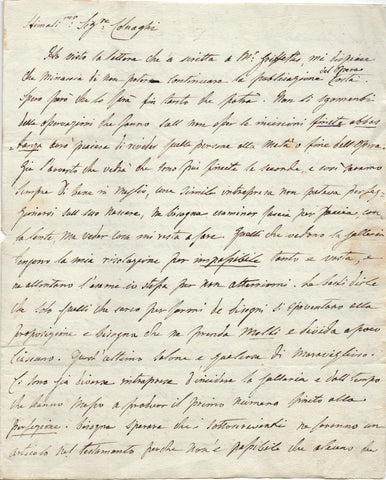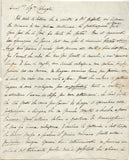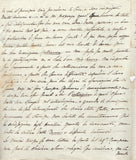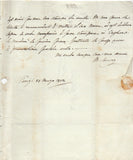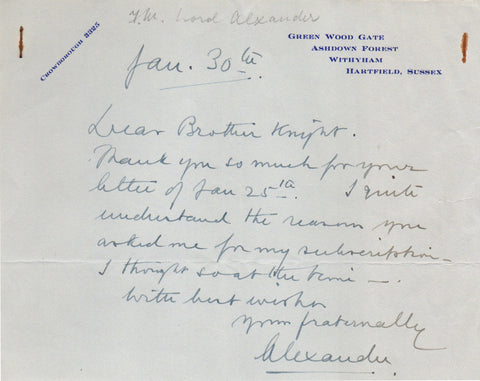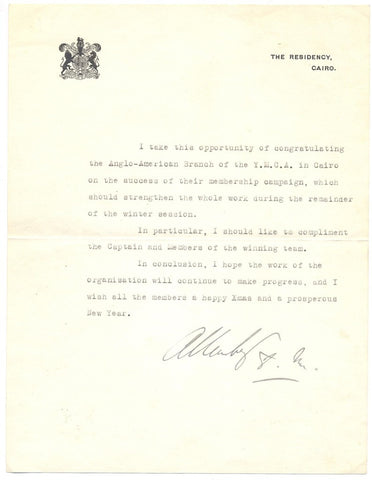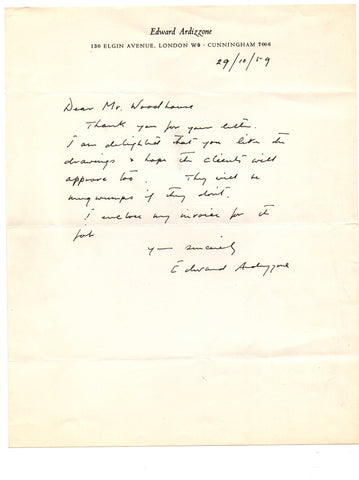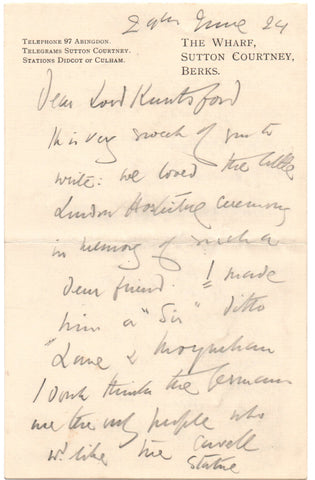COSWAY Maria - ALS 1802 defending her Galerie du Louvre project
Maria COSWAY (1760-1838)
Autograph Letter Signed (“M. Cosway”) to Mr. Colnaghi in Coxport [Cockspur] Street, defending the merits of a work on which she was engaged [The Galerie du Louvre, a project for a series of prints].
2½ pages 4to in Italian, with integral address leaf, Paris, 23 March 1802.
Trans: “I have seen the letter you have written to Mr. Griffiths, I regret the threat not to be able to continue the publication of the work. I hope however that you will do it as soon as possible. You must not be disheartened by the observations made that the etchings are not sufficiently finished, I should be pleased to see that person again when the work is finished or half finished. I warn you that he will see that the second is more finished and so we proceed from good to better, such an undertaking cannot be perfect at its birth, it must be examined piece by piece with the lens but see what there remains for me to do. Those who have seen the gallery hold that my scheme is impossible so vast is it, and I put off the examination myself not to be terror struck. It is enough to tell you that those whom I find to make designs for me are alarmed at the proposal, and we must take many and give a little to each. There are already various schemes for engraving the gallery and from the time taken to produce the first number finished to perfection, one must hope that the subscribers will leave a clause in their will, for it is not possible that anyone who sees the beginning will be there to see the end, and many engravers are employed and my scheme for this work is different to all others, and more satisfactory as giving a true idea of the gallery in two or three years at most, and how would that be possible if one had the pretension of making a finished work? Moreover I could not in any case attempt that which would be beyond my limits, that is to give no more than a picturesque description. I cannot say much either in justification or praise of my work, but I reply frankly to those who subscribe that they will not repent and those who make difficulties suspend judgement. Don’t think however that observations on the matter are disdained, thus you will always give me pleasure by communicating them, but it is always well to be quick to see the intention of this work. Much will be explained in the introduction, but I keep the most interesting descriptions till it is finished with the prints. I have no doubt it will meet with the approval both of amateurs and connoisseurs, but it is difficult to bear up against the criticisms of the ladies. A short time ago I sent you a letter from Siga. Rosaspina in which she asked for some tools for engraving. I now send you notices of a picture she is engraving. I have taken the liberty to advise her to put her name to it and she would like to know whether it is necessary to have it printed in English. I will send the first proof. Meanwhile I pray you to try and find her an outlet. . .”
Maria Cosway knew Paris well. She had spent time there with her husband, in the years immediately before the Revolution, when she enjoyed an amorous relationship with the American ambassador to the French court, Thomas Jefferson. In 1801, five years after the death of her only daughter, Maria left London and returned to Paris where she embarked on a monumental project, a series of etchings of the works of art in the Louvre. Although the Louvre was not yet the great repository of paintings and sculpture which it is today, it was being substantially enriched by works brought back to Paris from Napoleon’s victorious campaigns.
The prospectus, issued in March 1802, explained to prospective subscribers that the work would be issued in numbers of two etchings on separate plates, accompanied by “interesting anecdotes relative to the artists by J. Griffiths, Esq.” Subscribers included various members of Napoleon’s family (his uncle, Cardinal Fesch, was a friend of Maria Cosway) as well as the Prince of Wales.
Cosway had been warned about her partner in the scheme, Julius Griffiths, who appears to have had a reputation for unreliability. Her London agent, the esteemed firm of art dealers, Colnaghi, evidently found him equally problematical.
These problems, together with the resumption of hostilities between England and France in 1803 after the breakdown of the Peace of Amiens, curtailed this ambitious project and only a few plates appeared, in three parts. Maria eventually made her way to Italy, where she had been born, and opened a school for girls.
The letter is somewhat crumpled, especially at the right edge, there is a small hole at the fold, where the seal has been broken, and there is old tape at the right margin of the address leaf from previous mounting, but it remains in good, clear condition.
Delivery
Autographs can be delivered worldwide. Delivery costs are calculated at the time of order and items will be sent by the most appropriate means, depending on your location and the value of the item. This will usually be by Royal Mail Special Delivery within the UK and Royal Mail Tracked outside the UK.
The current delivery charges are:
-
UK:
Royal Mail Special Delivery £9.00
-
Europe:
Europe Royal Mail Tracked £15.00
EU customers should note that, following brexit, local VAT and customs duties may apply to their purchases.USA:
-
Royal Mail Tracked £25.00
Rest of the World:
-
Rest of the World Tracked £20.00
Export Licensing
Customers should be aware that all letters and documents over 50 years old require an export licence, which may delay delivery by anything from one to three weeks. Signed photographs are not subject to export licence regulations, and can be sent immediately.
There is no charge for the export licence and I will take care of the application, the only inconvenience to you will be the delay.
Authenticity
The authenticity of the letters and documents offered is guaranteed.
Payment
Online sales orders
Payments made via the website are processed by Shopify Inc and can be made using Visa, Mastercard or American Express.
Telephone sales orders
Items may be purchased by phone. Please contact me using the website Contact Form and I will call you within 48 hours to discuss your requirements. Payment for purchases ordered by phone can be paid upon receipt of the invoice and must be paid within 7 days. Phone orders can be paid by cheque (in pounds sterling only) or bank transfer.
Items will be reserved for one week following the order confirmation and will be dispatched either within 7 days after full payment has been received, or after any required export licenses have been granted.
Returns Policy
Should you be in any way dissatisfied with your purchase, items may be returned within six weeks of delivery and a full refund will be made upon receipt of the returned item. The item must be received by Richmond Autographs in the same condition as when dispatched. For full details, please read our Terms and Conditions.
We Also Recommend

